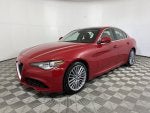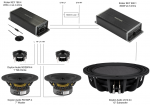I’m working on a build for my 2017 Alfa Romeo Giulia Ti with the base audio system. It’s a simple budget build and doesn’t compare to some of the incredible builds and equipment I’ve seen and been inspired by here in the past year of lurking. So many of you guys do awesome work. Recently another thread for this vehicle (with a nicer system) got bumped, and there was some interest, so to pay back some of all I’ve learned from you, I decided to cross post from giuliaforums, with a slightly different format for this audience.
For such a wonderful vehicle, the Giulia’s the base audio system is a travesty. It's simply worse than any car I've ever owned. The sound is impactless and flat, there is no dynamic range until volume 20 and it's harsh and tiring on long trips. The sound is unbalanced, with lots of cross talk from the tweeters in the rear doors near the driver and front passenger ears. I decided almost instantly I couldn't live with the audio performance. I haven’t done any aftermarket audio in a long time, not because factory systems are great, but until now they’ve been good enough. Given my slight indifference toward factory systems in my other vehicles (probably fortunate unfamiliarity with true high end aftermarket systems like are done here), I thought maybe a small amplifier in the Giulia could be sufficient to give the sound some life.
Like most other new vehicles, the Giulia has an integrated headunit (ETM), impractical to replace. The ETM in 2017 is the same hardware as the BMW - NBT Evo ID5/6, but doesn’t have optical out. In its BMW persona, it can be coded for lower level differential output, but as Giulia forums member Unique discovered, coding the premium Harmon Kardon (HK) mode via ODB causes loss of volume and fader control, because it’s is done via CAN bus on the HK system amplifier, needing something unavailable like the iDatalink Maestro. The Giulia also presents other integration difficulties with load detection requirements, auto start/stop and rumored electrical system sensitivity. The speakers are common to other Fiat and Alfa Romeo vehicles and not very high quality. There is a claimed 1” tweeter in the dash, and 6.5” woofers in the front doors. The same speakers are in the rear doors. The HK system has upgraded components and 3” mids in the front doors, dash and rear deck, along with a 6x9 IB subwoofer.
Base Speakers
![]()
I didn’t find many amplifiers explicitly listing auto start/stop compatibility: Audiotec Fischer Match/Helix and Kicker KEYs. I’m sure there are more and maybe I over thought it, but some manufactures (ahem Kenwood) won’t even answer the compatibility question. The Kicker KEY 180.4 seemed like a good candidate, inexpensive with Auto EQ DSP that might help the factory speakers sound better. My original plan was to install the KEY 180.4 in the dash near the ETM, but after opening the silencer panel under the steering wheel I discovered no space to install. So I started to rethink how, then what I wanted to do. The more I researched and found details of the components of the system, the more I wanted to replace them. This rekindled my forgotten car audio hobby and what I’ve been missing.
I decided to do a whole system, but didn’t want to spend a lot of money. I stuck with the stock locations, but given the capabilities of the KEY 180.4 I already had, decided to go active for the many benefits. This allowed replacing only the front speakers since, as previously stated, the rear tweeter locations bleed and completely ruin the imaging. The remaining system components were chosen around that decision; considering fit, function and reasonable cost. Raw component speakers ended up the best candidates, helping keep cost down. The following sections detail choices made and how they were installed.
![]()
![]()
System Diagram
![]()
For such a wonderful vehicle, the Giulia’s the base audio system is a travesty. It's simply worse than any car I've ever owned. The sound is impactless and flat, there is no dynamic range until volume 20 and it's harsh and tiring on long trips. The sound is unbalanced, with lots of cross talk from the tweeters in the rear doors near the driver and front passenger ears. I decided almost instantly I couldn't live with the audio performance. I haven’t done any aftermarket audio in a long time, not because factory systems are great, but until now they’ve been good enough. Given my slight indifference toward factory systems in my other vehicles (probably fortunate unfamiliarity with true high end aftermarket systems like are done here), I thought maybe a small amplifier in the Giulia could be sufficient to give the sound some life.
Like most other new vehicles, the Giulia has an integrated headunit (ETM), impractical to replace. The ETM in 2017 is the same hardware as the BMW - NBT Evo ID5/6, but doesn’t have optical out. In its BMW persona, it can be coded for lower level differential output, but as Giulia forums member Unique discovered, coding the premium Harmon Kardon (HK) mode via ODB causes loss of volume and fader control, because it’s is done via CAN bus on the HK system amplifier, needing something unavailable like the iDatalink Maestro. The Giulia also presents other integration difficulties with load detection requirements, auto start/stop and rumored electrical system sensitivity. The speakers are common to other Fiat and Alfa Romeo vehicles and not very high quality. There is a claimed 1” tweeter in the dash, and 6.5” woofers in the front doors. The same speakers are in the rear doors. The HK system has upgraded components and 3” mids in the front doors, dash and rear deck, along with a 6x9 IB subwoofer.
Base Speakers

I didn’t find many amplifiers explicitly listing auto start/stop compatibility: Audiotec Fischer Match/Helix and Kicker KEYs. I’m sure there are more and maybe I over thought it, but some manufactures (ahem Kenwood) won’t even answer the compatibility question. The Kicker KEY 180.4 seemed like a good candidate, inexpensive with Auto EQ DSP that might help the factory speakers sound better. My original plan was to install the KEY 180.4 in the dash near the ETM, but after opening the silencer panel under the steering wheel I discovered no space to install. So I started to rethink how, then what I wanted to do. The more I researched and found details of the components of the system, the more I wanted to replace them. This rekindled my forgotten car audio hobby and what I’ve been missing.
I decided to do a whole system, but didn’t want to spend a lot of money. I stuck with the stock locations, but given the capabilities of the KEY 180.4 I already had, decided to go active for the many benefits. This allowed replacing only the front speakers since, as previously stated, the rear tweeter locations bleed and completely ruin the imaging. The remaining system components were chosen around that decision; considering fit, function and reasonable cost. Raw component speakers ended up the best candidates, helping keep cost down. The following sections detail choices made and how they were installed.


System Diagram









































